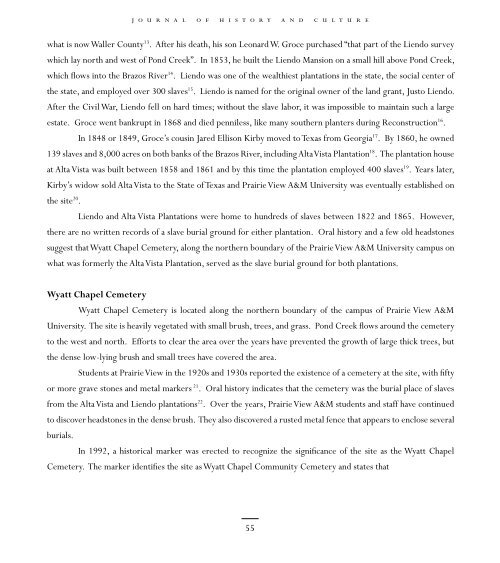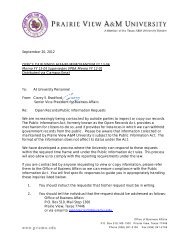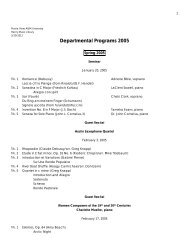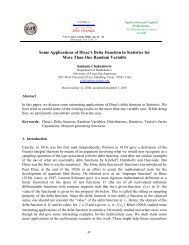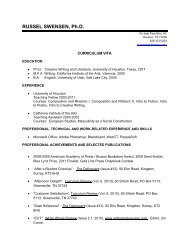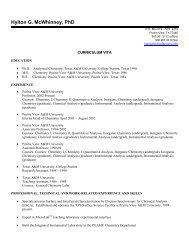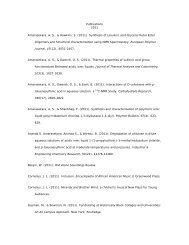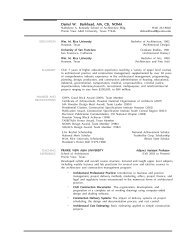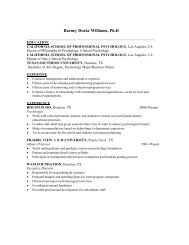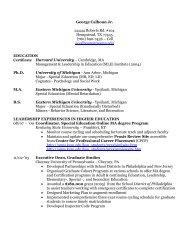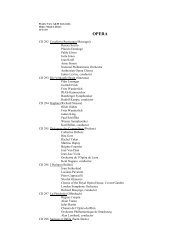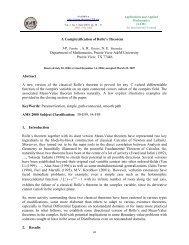Journal of History and Culture Journal of History and Culture
Journal of History and Culture Journal of History and Culture
Journal of History and Culture Journal of History and Culture
Create successful ePaper yourself
Turn your PDF publications into a flip-book with our unique Google optimized e-Paper software.
j o u r n a l o f h i s t o r y a n d c u l t u r e<br />
what is now Waller County 13 . After his death, his son Leonard W. Groce purchased “that part <strong>of</strong> the Liendo survey<br />
which lay north <strong>and</strong> west <strong>of</strong> Pond Creek”. In 1853, he built the Liendo Mansion on a small hill above Pond Creek,<br />
which flows into the Brazos River 14 . Liendo was one <strong>of</strong> the wealthiest plantations in the state, the social center <strong>of</strong><br />
the state, <strong>and</strong> employed over 300 slaves 15 . Liendo is named for the original owner <strong>of</strong> the l<strong>and</strong> grant, Justo Liendo.<br />
After the Civil War, Liendo fell on hard times; without the slave labor, it was impossible to maintain such a large<br />
estate. Groce went bankrupt in 1868 <strong>and</strong> died penniless, like many southern planters during Reconstruction 16 .<br />
In 1848 or 1849, Groce’s cousin Jared Ellison Kirby moved to Texas from Georgia 17 . By 1860, he owned<br />
139 slaves <strong>and</strong> 8,000 acres on both banks <strong>of</strong> the Brazos River, including Alta Vista Plantation 18 . The plantation house<br />
at Alta Vista was built between 1858 <strong>and</strong> 1861 <strong>and</strong> by this time the plantation employed 400 slaves 19 . Years later,<br />
Kirby’s widow sold Alta Vista to the State <strong>of</strong> Texas <strong>and</strong> Prairie View A&M University was eventually established on<br />
the site 20 .<br />
Liendo <strong>and</strong> Alta Vista Plantations were home to hundreds <strong>of</strong> slaves between 1822 <strong>and</strong> 1865. However,<br />
there are no written records <strong>of</strong> a slave burial ground for either plantation. Oral history <strong>and</strong> a few old headstones<br />
suggest that Wyatt Chapel Cemetery, along the northern boundary <strong>of</strong> the Prairie View A&M University campus on<br />
what was formerly the Alta Vista Plantation, served as the slave burial ground for both plantations.<br />
Wyatt Chapel Cemetery<br />
Wyatt Chapel Cemetery is located along the northern boundary <strong>of</strong> the campus <strong>of</strong> Prairie View A&M<br />
University. The site is heavily vegetated with small brush, trees, <strong>and</strong> grass. Pond Creek flows around the cemetery<br />
to the west <strong>and</strong> north. Efforts to clear the area over the years have prevented the growth <strong>of</strong> large thick trees, but<br />
the dense low-lying brush <strong>and</strong> small trees have covered the area.<br />
Students at Prairie View in the 1920s <strong>and</strong> 1930s reported the existence <strong>of</strong> a cemetery at the site, with fifty<br />
or more grave stones <strong>and</strong> metal markers 21 . Oral history indicates that the cemetery was the burial place <strong>of</strong> slaves<br />
from the Alta Vista <strong>and</strong> Liendo plantations 22 . Over the years, Prairie View A&M students <strong>and</strong> staff have continued<br />
to discover headstones in the dense brush. They also discovered a rusted metal fence that appears to enclose several<br />
burials.<br />
In 1992, a historical marker was erected to recognize the significance <strong>of</strong> the site as the Wyatt Chapel<br />
Cemetery. The marker identifies the site as Wyatt Chapel Community Cemetery <strong>and</strong> states that<br />
55


